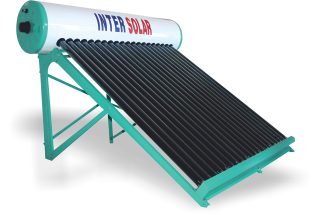Solar Water Heating System
Solar Water Heating System

Flat Plate
Inter Solar Water Heating System works on the principle of black body absorption. The Selective Coatings used in solar collector absorbs solar radiation and convert it to Heat Energy. The hot water rises up in the risers of the collector & returns to the hot water storage tank. There is no requirement of motor or pump to circulate in thermosyphon type system however in forced system the pump is required for circulation of water.
Etc Tube
The Three super high efficiency selective coating on the inner cover of high boron and silicon content evacuated tubes absorbs the heat. When temperature rises, the density of water drops and weight goes down, hot water will go up to exchange with cold water in tank. In this way, the temperature of the water in tank goes up. ETC technology is suitable for domestic non-pressurised hot water application.

A solar water heating system (also called a solar thermal system) uses sunlight to heat water for residential, commercial, or industrial use. It reduces the need for electricity or gas to heat water, leading to energy savings and lower carbon emissions.
Types of Solar Water Heating Systems
Active Systems (With Pumps)
-
Use electric pumps to circulate fluid through collectors.
-
More efficient and suitable for colder climates or larger systems.
Two Subtypes:
-
Direct (Open-loop): Water flows directly through the collector.
-
Best for mild, non-freezing climates.
-
-
Indirect (Closed-loop): Heat transfer fluid (like antifreeze) circulates through a closed loop.
-
Ideal for cold or freezing areas.
-
Passive Systems (No Pumps)
-
Use natural convection to circulate water.
-
Fewer parts = lower cost and maintenance.
Two Common Types:
-
Integral Collector Storage (ICS): Collector and storage combined.
-
Good for warm climates.
-
-
Thermosyphon: Tank is mounted above the collector, using gravity flow.
-
Reliable and simple, but may need roof reinforcement
-
1. Energy Savings
Uses the sun’s free energy to heat water, reducing electricity or gas consumption by up to 60–80%.
2. Environmentally Friendly
Reduces carbon emissions and dependence on fossil fuels, supporting clean and green energy.
3. Cost Effective Over Time
Although the initial cost is higher, the low operating cost and reduced utility bills make it cost-effective in the long term.
4. Low Maintenance
Most systems require minimal maintenance, especially passive systems with no moving parts.
5. Energy Independence
Reduces reliance on grid power or fuel, especially beneficial in remote or off-grid locations.
6. Government Incentives
Many governments offer subsidies, tax rebates, or incentives, reducing the upfront cost.
7. Reliable and Proven Technology
Well-established and durable, with a lifespan of 15–20+ years.
8. Year-Round Hot Water
Delivers hot water even in winter or cloudy days, using backup heating if needed.
9. Reduces Peak Load on Grid
Helps lower the morning and evening electricity demand, benefiting utility providers and users alike.
10. Improves Property Value
Eco-friendly features like SWHS are seen as valuable upgrades, enhancing property resale value.